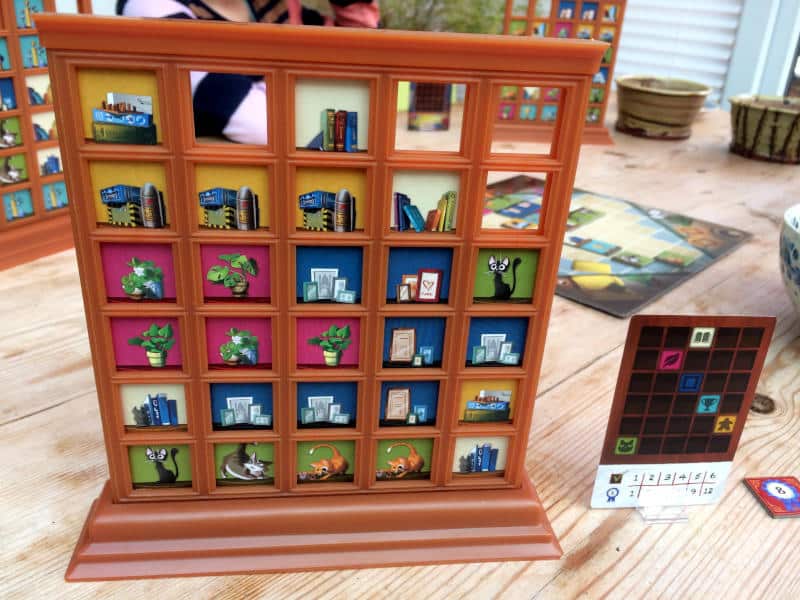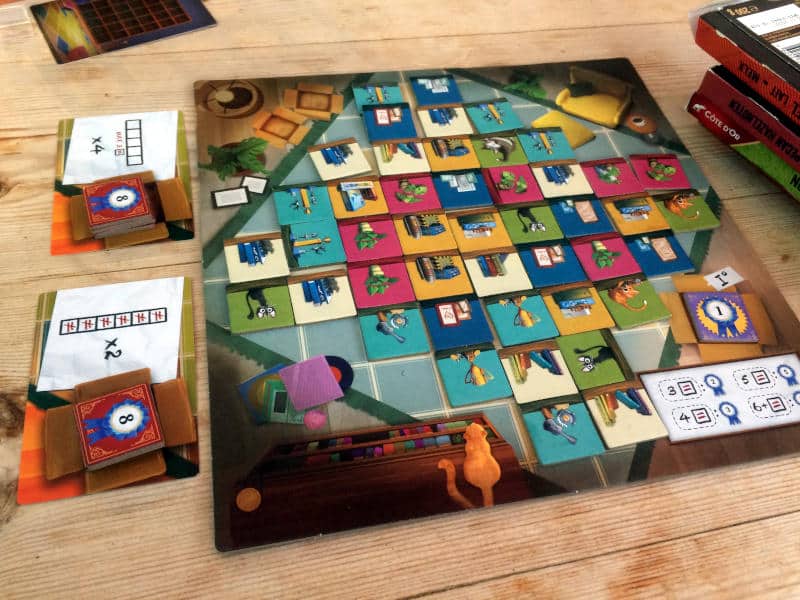| Release Date: 2023 | Players: 2-4 |
| Designer: Matthew Dunstan, Phil Walker-Harding | Length: 30-45 minutes |
| Artist: Sara Valentino, Shannon Grosenbacher | Age: 8+ |
| Publisher: Lucky Duck Games | Complexity: 1.5 / 5 |
| Plastic (by weight): n/a | Air (by volume): n/a |
The living room floor was a mess, sort of anyway. Everything was neatly arranged in a grid pattern, but there was no order to it whatsoever. Books were next to plants, which were next to games, which were next to frames all while some of our cats were tiptoeing around everything. All of it was only temporary though. I just wanted to get everything lined up, before returning it all to My Shelfie by Matthew Dunstan and Phil Walker-Harding from Lucky Duck Games.
I absolutely love, love, love games where you have to create patterns following a set of rules to score the most points. These games scratch a certain itch for me. I also really enjoy tile-laying. So when both come together in a game, I can be pretty confident that I’ll like it. The recent Village Rails, which was also designed by Matthew Dunstan, but this time in co-operation with Brett J. Gilbert, is a good example.
Unlike Village Rails though, My Shelfie scales it all right back to the bare bones and only adds a couple of things to make the resulting game an interesting mix. It is light enough on rules to be a great family game, while offering players the opportunity to make sometimes tough decisions and plan ahead, if that’s what you want to do. At the same time though, you can just play with your gut and do well. So there really is something for everyone. You can have a quick, fun game without too much thinking or you can play really competitively and plan ahead.
Shelfie Toy Factor
Visually, My Shelfie is also very appealing. The central game board, which is called the living room floor in the game and is filled with many, many square tiles in one of six colours looks great and has some fitting illustrations in the corners to make it attractive. Each tile’s artwork is slightly different and functions as a way of double-coding the colours. So if you’re colour-blind, you’ll still be able to tell a cat tile from a book tile for example.
The main attraction is the shelf itself though. There is a certain toy factor about it. You’re immediately reminded of Connect Four. Of course, just like Connect Four, My Shelfie doesn’t actually need the vertical plastic grid. You could easily play both games by putting pieces on a horizontal grid printed on a central board. That would have reduced the amount of plastic hugely.
However, not only do the plastic shelves have real table presence, but a key rule in both games happens automatically. Gravity pulls the tiles down, so they stack as you slide them into a slot. There is no need to explain that. It’s immediately clear and reduces the rules overhead in the game greatly. So, for me, who prefers a reduction of the use of plastic in our hobby, using these plastic shelves was the right choice. If they’d been wood, it would have been better, but I assume that would have made My Shelfie much more expensive.

Clever Drafting
I also love the tile drafting. You have to always take at least one and up to three tiles from the living room floor and add them to one of the slots in your shelfie. The tiles have to be either all in the same row or the same column on the central board. In other words, they have to be all horizontally or vertically adjacent. Not only that, but all of the tiles you take must have at least one free side, meaning one edge is not next to another tile.
That really limits your choices and every tile you take will free up more tiles for other players. So the competitive player will carefully consider which tiles they take, aiming not to give other players the tiles they might need. A bit of planning here can make a difference. Alternatively, as I said before, you can just go with your gut and take those tiles that work best for you and ignore what other players are doing.
Additionally, the starting layout of the tiles means that the starting player actually has fewer options. So going first is not necessarily the best. You technically have a bigger choice of tiles, but you can’t take as many, as they won’t have a free edge.
Free Flow
On the whole, My Shelfie plays quite quickly. While others are taking their turns, you can roughly work out what tiles you’re going to take on your turn. There is no guarantee that they will be available when the game comes around to you, but it does help to look at your options before it’s your turn again.
You can also slightly overlap turns. Once someone has taken their tiles, the next player can take their turn. There usually is no need to wait. The previous player can work out what column to slot their tiles in as the next player chooses theirs. Chances are that the current player has already made that decision before they took the tiles from the living room floor.
However, there is one thing that really stops the flow of My Shelfie. That’s when there are only four tiles on the central game board. That’s when new tiles have to be drawn and the floor is refilled again. Even when everyone helps out and you go as quickly as you can, it still creates a break in the flow of the game. It’s really noticeable and I wish there was a way to change it. At the end of the day though, it is what it is and it’s not like you’re spending most of the game refilling tiles.

Shelf of Opportunity
As a whole experience, My Shelfie is really good. It scratches all the right itches for me. It works as a light, easy game as well as one that is enjoyable for highly competitive players. It’s got great table presence, the right amount of toy factor and tactility. It also deals with colour blindness, while not skimping on visual appeal, which is great. The game length is also just right, allowing you to easily play two or more games back to back over an afternoon or evening with friends or family. My Shelfie is the sort of game that will come out again and again, making it a real evergreen title for me.
So, yes, if you like patterny tile-laying games with toy appeal, then My Shelfie is definitely for you.
Useful Links
- My Shelfie: https://luckyduckgames.
com/ games/ 340-my-shelfie - Rulebook: https://boardgamegeek.
com/ filepage/ 243983/ my-shelfie-rules-eng - Lucky Duck Games: https://luckyduckgames.
com/ - BGG listing: https://boardgamegeek.
com/ boardgame/ 366456/ my-shelfie - Village Rails review: https://tabletopgamesblog.
com/ 2023/ 03/ 11/ village-rails-saturday-review/ - Connect Four: https://boardgamegeek.
com/ boardgame/ 2719/ connect-four
Transparency Facts
I feel that this review reflects my own, independent and honest opinion, but the facts below allow you to decide whether you think that I was influenced in any way.- I was sent a free review copy of this game by the publisher.
- At the time of writing, neither the designers, nor the publisher, nor anyone linked to the game supported me financially or by payment in kind.
Audio Version
Intro Music: Bomber (Sting) by Riot (https://www.
Sound Effects: bbc.co.uk – © copyright 2023 BBC
Music I use: Bensound
License code: TZCU6NUICWCIME5P
Playlist
These are the songs I listened to while I was writing this review:

